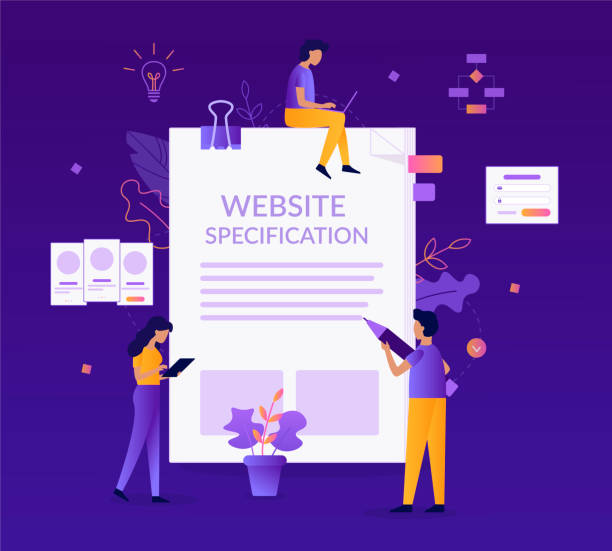Introduction to Responsive Website Design and its Importance in the Current Era

In today’s fast-paced world, where #internet has become an integral part of daily life, how users access #web_content has gained increasing importance.
Websites can no longer be designed solely for display on large desktop computer screens.
With the widespread use of smartphones, tablets, and even wearable devices, the need for a seamless and optimized #user_experience across all these platforms is vital.
This is where the concept of Responsive Web Design comes into play.
This pioneering approach allows websites to automatically adapt their layout and elements to the screen size of the device the user is employing.
In this section, we provide a comprehensive explanation of why responsive web design is no longer an option, but a necessity.
This type of responsive website design is not just about changing font sizes or shrinking images; it’s a holistic approach to delivering the best visual and functional experience on every device.
Since users expect to access information anytime, anywhere, your website must be able to meet this demand.
Ignoring this principle can lead to losing your audience and reducing engagement with your website.
This issue is not only important for users but also crucial for Search Engine Optimization (SEO).
Google and other search engines prefer responsive websites in their mobile search rankings.
This is an important lesson that businesses and developers must consider to stay ahead of the competition.
A website that is not properly responsive can offer a poor user experience and cause dissatisfaction among visitors, which in turn helps reduce bounce rate and increase user dwell time.
The importance of this in today’s digital world is undeniable.
Are you tired of losing business opportunities due to not having a professional corporate website?
RasaWeb helps you with professional corporate website design:
✅ Build a powerful and reliable brand image
✅ Convert website visitors into loyal customers
⚡ Get a free consultation now!
What are the Principles and Fundamentals of Responsive Design?

To understand how responsive design works, we need to delve into its fundamental principles.
These principles are the foundations that allow websites to dynamically adapt to their environment.
The first and perhaps most important principle is the use of Media Queries in CSS.
Media Queries allow developers to apply different styles based on device characteristics such as screen width, height, orientation, and resolution.
This is a powerful specialized tool that enables us to optimize the user experience for each device.
The second principle is Flexible Grids.
Instead of using fixed widths (pixels), responsive design employs relative units like percentages or ems for element widths.
This means that the website layout, instead of being tied to a specific size, can fluidly resize and adapt to the available space.
This approach guides us on how to display content proportionally across different devices.
The third and equally important principle is Flexible Images and Media.
Images must also be able to resize proportionally to their parent width to prevent content overflow or being displayed too large.
This is often achieved by setting `max-width: 100%` in CSS for images.
Also, loading images with appropriate quality for each device, without sacrificing speed, is an important educational challenge.
These principles together form the core of responsive design, and understanding them is essential for any web developer.
This approach not only ensures visual appeal but also improves site performance across diverse platforms.
Challenges Ahead in Implementing Responsive Design

Despite its many advantages, implementing responsive design is not without its challenges.
One of the biggest obstacles is the complexity of testing and debugging.
With countless variations of devices, screen sizes, and browsers, ensuring that the website functions correctly under all conditions can be extremely difficult.
This is a deep analysis of the development process that requires great precision and patience.
Developers must use simulation tools, real tests on different devices, and advanced debugging techniques to resolve potential issues.
Another challenge is content and performance management.
Sometimes, what looks beautiful on a large screen becomes cluttered and unusable on a small screen.
This is where the questionable content issue arises: should certain content be hidden on smaller devices or should its display method be altered? Also, site loading speed is a major concern.
If unnecessary images and code are loaded for mobile devices, it can severely harm the user experience and lead to an increased bounce rate.
This requires deep expertise in optimizing resource loading.
Here is a table comparing common challenges and solutions in implementing responsive design:
| Challenge | Description | Solution |
|---|---|---|
| Complex Testing | Need to test on various devices and browsers | Use simulator tools, real device testing, automated testing services |
| Content Management | Optimal content display on small screens | Content prioritization, use of mobile-first design patterns |
| Loading Speed | Large volume of images and scripts | Image optimization (lazy loading, new formats), code compression, use of CDN |
| Complex Navigation | Large menus and difficult access on mobile | Hamburger menus, bottom navigation, simple and intuitive design |
Despite these challenges, the advantages of responsive website design far outweigh them, and with the right approach, these obstacles can be overcome to deliver an excellent user experience.
The Impact of Responsive Design on SEO and User Experience

One of the most important reasons that has made responsive website design an industry standard is its profound impact on Search Engine Optimization (SEO) and User Experience (UX).
These two concepts are highly intertwined, and a responsive website helps both perform at their best.
From an SEO perspective, Google has explicitly stated that it prioritizes Mobile-First Indexing.
This means that Google’s bots primarily examine the mobile version of your website for content ranking.
Therefore, if your website is not optimized for mobile, it may suffer in search results.
A responsive website means having a single URL for each page, which simplifies SEO management and prevents duplicate content issues that can arise with separate mobile/desktop versions.
This is an important explanation for anyone looking to improve their site’s ranking on Google.
Furthermore, site loading speed is also a crucial factor in SEO.
Responsive websites, by optimizing resources for each device, help improve site loading speed, which in turn positively impacts SEO ranking and user satisfaction.
This is a continuous cycle where SEO and UX reinforce each other, and responsive website design is at the heart of this synergy.
Does your current corporate website not reflect your brand’s credibility and power as it should? RasaWeb, with its professional corporate website design services, solves this challenge for you.
✅ Increase credibility and visitor trust
✅ Targeted attraction of more customers
⚡ Click now for a free consultation!
Common Tools and Frameworks in Responsive Website Design

To effectively implement responsive design, developers utilize a set of tools and frameworks that simplify and streamline the process.
Understanding these tools is crucial for anyone looking to design modern, adaptable websites.
One of the most popular and comprehensive frameworks is Bootstrap.
This framework provides HTML, CSS, and JavaScript for rapid and easy development of responsive websites.
Bootstrap, with its powerful Grid System and pre-built UI components, greatly simplifies work for developers and offers comprehensive guidance for building web components.
Another framework worth mentioning is Foundation.
Like Bootstrap, Foundation offers a set of ready-to-use tools for responsive design, but it is often known as a “mobile-first” framework with greater customization capabilities.
The choice between Bootstrap and Foundation usually depends on personal preferences and project needs.
These frameworks, by providing standard and optimized code, help reduce development time and ensure cross-browser compatibility.
In addition to full frameworks, other tools also exist for responsive website design.
For example, browser developer tools (like Chrome DevTools) offer capabilities to simulate different screen sizes and test website responsiveness.
Online responsive testing tools can also quickly check your site’s responsiveness across various views.
Ultimately, mastering CSS Media Queries and Flexbox/Grid Layout in CSS, without the need for large frameworks, is also a vital specialized skill for implementing responsive website design.
Using these tools not only simplifies the design process but also improves the quality and performance of the final website.
Key Tips for Optimizing Images and Videos in Responsive Design

Images and videos are essential components of any website, but if not properly optimized, they can become a major obstacle to site loading speed and user experience in responsive website design.
One of the most important tips is to use the `srcset` and `sizes` attributes in the HTML5 `` tag.
These attributes allow the browser to load the most suitable image version based on the user’s device screen size and resolution.
This is an advanced guideline that helps save bandwidth and increase speed.
For images, in addition to `srcset`, the use of modern image formats like WebP or AVIF is also recommended.
These formats offer better compression than JPEG or PNG without significantly reducing visual quality.
This is an important specialty for any web developer.
Also, implementing Lazy Loading for images and videos is crucial.
With Lazy Loading, media content is only loaded when the user scrolls to that part of the page, which significantly improves initial page loading speed.
Regarding videos, instead of directly embedding videos with `iframe` from platforms like YouTube or Vimeo, one can use the HTML5 `
Is Responsive Design Suitable for All Websites?

While responsive design has been adopted as the standard approach for most modern websites, the questionable content arises whether this approach is the best option for all projects and types of websites? The short answer is: almost for most websites, yes, but there are exceptions.
In some specific cases, Adaptive Design or even a completely separate mobile version might be a more suitable option.
Adaptive design, instead of fluidly adapting to every screen size, provides separate layout versions for a predefined set of screen sizes (breakpoints).
This can be useful for websites that require very precise control over every pixel on each device or when content and functionality differ significantly between devices.
This is a precise analysis of the specific needs of the project.
For example, a complex web application that requires a much simpler user interface on mobile might benefit more from adaptive design.
However, for most content-driven websites, blogs, online stores, and corporate websites, responsive website design remains the best choice.
The main reasons are ease of maintenance (a single codebase), better SEO performance (a single URL per page), and providing a unified and optimized user experience across all devices.
This is an important explanation for deciding on the design method.
Below is a table comparing responsive design and adaptive design:
| Feature | Responsive Design | Adaptive Design |
|---|---|---|
| Principles | A single layout that adapts to any screen size. | Multiple fixed layouts for specific screen sizes. |
| Implementation | Uses Media Queries, Flexible Grids, Flexible Images | Identifies device type and loads appropriate layout |
| SEO | Single URL, optimized for Mobile-First Indexing | Requires redirect management, potential duplicate content issues |
| Maintenance | Single codebase, simpler | Multiple codebases, more complex |
| Flexibility | Very flexible, for all sizes | Limited flexibility to defined breakpoints |
In conclusion, for most projects, responsive design is not only more responsive but also easier to maintain in the long run and yields better SEO results.
The Future of Web Design and the Role of Responsive Design in It

Looking at the future horizon of web design, it is clear that responsive design will not only maintain its position but also be at the center of new developments.
This is important news for anyone working in this industry.
With the emergence of new technologies such as Progressive Web Apps (PWAs), websites are evolving towards experiences similar to native applications.
PWAs, using modern browser capabilities, offer features like offline work, push notifications, and home screen installation, all built on a foundation of responsive design.
The Mobile-First trend, currently a guiding principle in design, will be further strengthened in the future.
Developers first design the user experience for the smallest screen and then scale up to larger devices.
This approach helps responsive design ensure that essential content and features are available on mobile devices, which is crucial for increasing engagement and reducing bounce rates.
This is an analysis of current and future trends that emphasizes the importance of this paradigm.
Furthermore, with the proliferation of diverse smart devices such as smart TVs, smartwatches, and even in-car infotainment systems, the need for website design that can adapt to all this variety is felt more than ever.
This is a questionable content how websites can perform well in this complex ecosystem.
Responsive design is a fundamental tool to achieve this goal, allowing developers to provide a single, flexible experience instead of creating separate versions for each device.
The future of web design is moving towards greater convergence and flexibility, and responsive design will be the backbone of this evolution, allowing websites to be accessible and engaging on any platform.
Does your current corporate website present a worthy image of your brand and attract new customers?
If not, transform this challenge into an opportunity with RasaWeb’s professional corporate website design services.
✅ Significantly improves your brand’s credibility and image.
✅ Paves the way for attracting new leads and customers.
⚡ For a free and specialized consultation, contact RasaWeb now!
Case Study: Successful Examples of Responsive Website Design

To better understand the effectiveness of responsive website design, reviewing successful examples can be very educational and inspiring.
These websites demonstrate how, by correctly implementing responsive principles, a seamless user experience can be provided across all devices.
One of the most prominent examples is The New York Times website.
This website not only offers rich news content but also, with its professional responsive design, ensures readability and accessibility of news on any device, from large desktops to small smartphones.
The use of variable font sizes, flexible columns, and image optimization makes the reading experience excellent for users.
This is an analysis of a real-world example.
Another example is Google‘s website itself.
From the search engine to various services like Google Maps or Google Drive, all are implemented with a responsive design approach.
These websites, by automatically adapting to screen dimensions, allow users to effortlessly use Google services on any device.
This is a great example of a responsive website that combines functionality and simplicity.
Also, many large online stores like Amazon or Digikala also use responsive design.
This allows customers to easily browse products, add them to the cart, and complete their purchases on any device.
This is an important explanation for businesses looking to increase online sales.
The success of these websites is a testament to the power of responsive website design in providing a comprehensive user experience and increasing user engagement.
These examples show that investing in responsive design yields significant returns.
Step-by-Step Guide to Converting an Old Website to Responsive

Converting an old website that was not designed responsively into a responsive site can be a challenging but essential project.
This is a step-by-step guide to doing so.
Step One: Evaluation and Planning. First, assess the current state of your website.
Which sections need the most changes? What content should be prioritized? Create a roadmap for different layouts (mobile, tablet, desktop).
This stage involves a precise analysis of the existing structure.
Step Two: Add the Viewport Meta Tag. This HTML tag is placed in the `
` section of your page and tells the browser to adjust the page width to match the device width:<meta name="viewport" content="width=device-width, initial-scale=1.0">This is the first and most crucial step to enabling responsive design.
Step Three: Rebuild CSS with Media Queries. Use Media Queries to apply different styles based on screen width.
Start with a “mobile-first” approach; that is, write the main styles for mobile and then apply changes for larger devices (e.g., `min-width: 768px`) using Media Queries.
This is a technical specialty.
/* Base styles for mobile */
body { font-size: 16px; }
/* For tablets and larger */
@media (min-width: 768px) {
body { font-size: 18px; }
.container { width: 90%; }
}
/* For desktops and larger */
@media (min-width: 1024px) {
body { font-size: 20px; }
.container { width: 80%; max-width: 1200px; }
}
Step Four: Optimize Images and Media. Ensure your images and videos are flexible (with `max-width: 100%`) and use `srcset` and `sizes` to provide optimized images.
Step Five: Test and Debug. Thoroughly test your website on different devices and browsers.
Use browser developer tools and online testing services to identify and fix issues.
This is practical and vital training to ensure your responsive website design functions correctly.
Frequently Asked Questions
| Question | Answer |
|---|---|
| What is Responsive Web Design? | It is a method for designing and implementing websites that automatically adjusts the layout and content of the page based on the user’s device screen size (desktop, tablet, mobile, etc.) to display in the best possible way. |
| Why is Responsive Design important? | With the increasing use of various devices to access the web, a responsive site improves user experience, reduces bounce rate, strengthens site SEO, and makes site management and maintenance easier (instead of having separate versions for mobile and desktop). |
| How does Responsive Design work? | This type of design uses techniques such as flexible grids and layouts (Flexbox, CSS Grid), flexible images and media, and most importantly, CSS Media Queries to change page styles and layout based on screen characteristics (width, height, resolution, etc.). |
| What are the main tools for implementing Responsive Design? | Main tools include HTML5 (for content structure), CSS3 (especially Media Queries, Flexbox, Grid for responsive styling and layout), and sometimes JavaScript for more complex interactions. |
| What are the main advantages of using Responsive Design? | The main advantages include increased user accessibility (covering a wide range of devices), improved user experience, better site ranking in search engines (especially Google), reduced development and maintenance costs, and increased visitor-to-customer conversion rates. |
And other services of RasaWeb Advertising Agency in the field of advertising
Smart Social Media: A creative platform for improving customer behavior analysis with precise audience targeting.
Smart Marketing Automation: Revolutionize customer acquisition by optimizing key pages.
Smart Marketplace: A fast and efficient solution for campaign management focusing on marketing automation.
Smart Digital Advertising: An effective tool for digital branding by customizing user experience.
Smart Marketing Automation: A novel service to enhance SEO ranking through key page optimization.
And over hundreds of other services in the field of internet advertising, advertising consultation, and organizational solutions
Internet Advertising | Advertising Strategy | Advertorials
Resources
What is Responsive Website Design?
The Importance of Responsive Design
An Introduction to Responsive Website Design
Principles of Responsive Design
? Transform your business in the digital world and achieve your big goals with RasaWeb Digital Marketing Agency. We pave your path to success by providing services such as professional website design, SEO, and content marketing.
📍 Tehran, Mirdamad Street, next to Bank Markazi, Kazeroun Jonoubi Alley, Ramin Alley, No. 6

